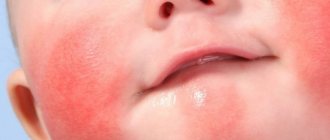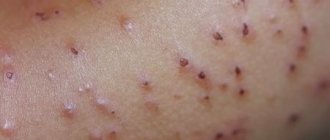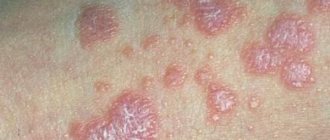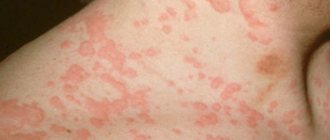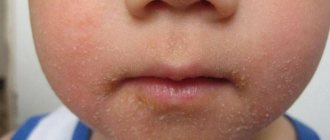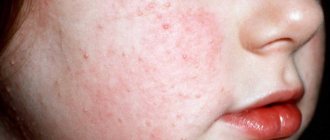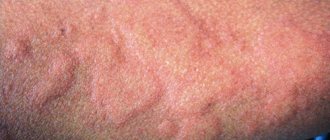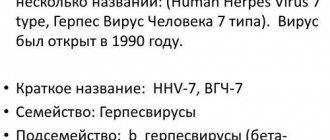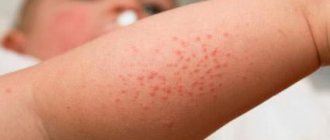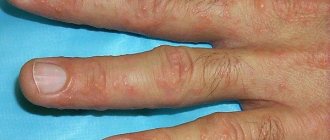Causes of impetigo
Impetigo is a skin disease in which the surface becomes covered with pustules.
The infectious process in them is caused by such pathogenic microflora as staphylococci and streptococci, among which Staphylococcus aureus, pyogenic and hemolytic streptococci, and various combinations thereof are most often identified. The spread of infection occurs through damage to the skin; it is localized in the hair follicles, where it actively multiplies and causes the appearance of a pustular rash. As pustules develop, they burst, and in their place dried purulent crusts and sometimes erosive lesions form. It is noted that about 20-40% of adults are carriers of Staphylococcus aureus localized on the nasal mucosa, and in 20% it is concentrated in the perineum and armpits. Streptococci first colonize the skin, and over time, the nasopharynx. The cell wall of these microorganisms contains teichoic acids, which, when the epidermis is damaged, bind to fibronectin, a protein of human cell membranes.
Primary infection most often develops in children. Children and young people are more likely to suffer from bullous impetigo. Secondary infection occurs against the background of itchy dermatoses and injuries with a violation of the integrity of the epidermis. Contributing factors for impetigo :
- itchy dermatoses,
- childhood,
- minor injuries,
- high temperature and humidity of the environment,
- unsanitary conditions,
- failure to comply with hygiene rules.
All these factors contribute to the settlement and reproduction of these microorganisms on the skin. Autoinoculation is possible (transfer of pathogens by hands during washing to other areas) and, as a result, dissemination of the process.
The clinical picture of impetigo is manifested by the appearance of superficial vesicles and blisters with a flaccid coating on the skin, the contents of which quickly turn purulent (pustules), and an erythemal border forms around it. Pustules quickly collapse with the formation of erosions, on the surface of which yellow-brown or honey-yellow crusts form as a result of drying of the exudate.
The number of elements increases, they grow along the periphery, merge, and form significant foci.
Doctors distinguish several clinical types of impetigo .
Ring-shaped impetigo. In the center of the lesions, a reverse development is observed, and along the periphery - yellow-brown crusts in the form of rings and arches; lesions with scalloped (in the form of half rings) boundaries are formed, along the periphery of which new pustules appear, which determines the growth of the lesions.
Acute diffuse impetigo. It is most often localized on the skin of the extremities, where within a short time significant erosive foci are formed, covered with exfoliated, wrinkled epidermis. On the periphery of the lesions, pustules with a thin crust are observed. The outbreaks spread relatively quickly.
Impetigo of the scalp. It is characterized by yellow crusts, which patients often comb and moist erosive areas form in these places, where crusts form again; hair sticks together.
Impetiginous (purulent) rhinitis - purulent crusts and erosions form on the nasal mucosa.
Impetiginous cheilitis (inflammation of the mucous membrane of the lips) is characterized by hyperemia, swelling, the formation of purulent crusts and painful cracks. With impetigo of the corners of the mouth (jams), slit-like erosion develops in the corners of the mouth against the background of erythema, there are yellow-brown crusts, pustules and slight infiltration along the periphery.
Bullous impetigo. Blisters appear with a thin, flabby crust and cloudy or purulent contents. They quickly collapse to form a shiny, moist, glossy surface, on which yellow crusts subsequently form.
The course of the disease without treatment can take several weeks or months. Rational therapy eliminates the process within 5-7 days.
Impetigo does not leave scars, only secondary spots (so-called temporary pigmentation), which subsequently disappear on their own.
Outbreaks are possible in children's groups, so sick children are not allowed into children's groups.
What causes impetigo
Doctors distinguish between primary and secondary types of infection. If infection occurs through a small wound or scratch, then this is primary pyoderma. When the disease develops due to a skin disease, the patient is diagnosed with secondary impetigo. The following factors increase the risk of developing the disease:
- frequent injuries to the skin - scratching insect bites, cuts, scratches;
- staying in a hot, humid climate;
- failure to comply with personal hygiene rules;
- diseases of the endocrine system;
- weakened immunity;
- contact with an infected person;
- obesity and profuse sweating;
- long-term use of certain ointments.
At risk are preschool children, pregnant women and the elderly, as well as people who regularly visit the bathhouse or sauna. Poor functioning of the immune system affects the general condition of the body. He stops fighting the emerging infection, which is why almost all diseases appear.
How to treat impetigo?
Treatment for impetigo depends on its type and severity. In cases of generalized rashes, general therapy with antibiotics and sulfonamides is indicated. Ointments of miramistin and streptocide, as well as liniments of streptocide and syntomycin are used locally. Oflocain, baneocin, bactroban, fucorcin and other agents demonstrate their effectiveness against impetigo pathogens. During treatment of impetigo, it is forbidden to take baths to eliminate the possibility of auto-inoculation. It is recommended to wipe the skin around the foci of impetigo with chloramphenicol.
As part of the prevention of impetigo, treatment and isolation of patients, especially children, should occur in a timely manner, at the first suspicion of infection. Treatment of microtraumas with iododicerin and other disinfectants, adherence to a hygienic regime and elimination of factors predisposing the disease are indicated.
How do other types of disease manifest themselves?
Streptococcal impetigo is the formation of painful, red blisters with pus inside. After maturation, the blisters open and ulcers appear in their place.
Staphylococcal impetigo (photo available) is accompanied by small rashes. The degree of complications depends on how deeply the skin is affected.
Strepto-staphylococcal skin lesions are expressed in multiple purulent conflicts on the skin. The peculiarity of this form is the increase in the process - the capture of new areas of healthy skin.
In the case of simultaneous infection with both staphylococcal and streptococcal infections, the contents of the blisters become purulent, and after opening, massive crusts appear. Most often it forms on the skin of the face, and the process spreads very quickly due to the fact that Staphylococcus aureus is carried by hands. We looked at the symptoms in adults.
What diseases can it be associated with?
Impetigo belongs to the group of pyoderma, the origin of which is caused by staphylococci and streptococci.
Possible complications of impetigo develop with the aggressiveness of its causative agent, as well as with a long-term absence of adequate therapy:
- lymphangitis - inflammation of the lymphatic vessels, usually due to streptococcal infection, which is manifested by characteristic red stripes in the area of the affected nodes;
- purulent lymphadenitis - an acute form of inflammation of the lymph nodes, accompanied by the production of pus and the formation of abscesses;
- erysipelas is an infectious disease characterized by the appearance of lesions on the skin and mucous membranes with a characteristic border limited by serous or serous-hemorrhagic inflammation;
- phlegmon - acute purulent inflammation of fatty tissue;
- bacteremia - the presence of bacteria in the blood, in this case more often staphylococcus and streptococcus;
- sepsis is an infectious blood poisoning.
Features of each type
Ring-shaped affects the lower limbs and hands.
Lichen simplex affects the face in children.
Slit-shaped impetigo is a specific type: it affects people who sleep with their mouth open, from which saliva flows. It is also a consequence of frequent lip licking.
Bullous impetigo is characterized by the presence of large blisters (up to two centimeters). The blisters contain blood and cloudy fluid.
Syphil-like is observed in newborns. Localization on the buttocks. It looks like chancre (syphilis). It goes away on its own and leaves no traces.
Vegetative impetigo is characterized by the formation of self-opening blisters throughout the body, and erosions with purulent crusts are formed.
Mucosal impetigo, by definition, affects the mucous membranes of the mouth, nose, and eyes.
Intertriginous streptoderma is manifested by damage to large skin folds with increased humidity and sweating. Characterized by rapid spread.
Treatment of impetigo at home
Treatment of impetigo is possible at home, but the patient must be isolated as much as possible from healthy relatives in order to avoid the spread of infection. Self-medication should not be carried out at home; consultation with a doctor is advisable for the reason that impetigo is most often caused by bacterial microflora and requires the use of antibiotics. Independent choice of antibacterial agents, even for external use, does not always live up to expectations, but on the contrary can provoke pathogen resistance to the drug.
The use of medications prescribed by a doctor should last in accordance with the dosages and duration of the main course. It is important to adhere to hygiene, strengthen the immune system, and lead a healthy lifestyle.
Personal hygiene
Personal hygiene is very important, since one of the factors that influences the development of infection is skin contamination. Also, an active lifestyle and exercise help reduce the risk of impetigo. Proper nutrition plays an important role.
Include butter, cheese, fish, chicken liver in your diet, and also eat as many vegetables and fruits as possible. During the period of illness, it is very important to pay attention to taking vitamins D and C. In addition to all this, it is recommended to take medications that contain a vitamin-mineral complex: “Alphabet Classic”, “Multimax”, “Revit”, “Complivit”.
What is pyoderma? We have answered this question.
What medications are used to treat impetigo?
Miramistin is a ready-to-use spray, applied by spraying the affected surfaces.
Streptocide - 5-15 grams of sterile powder is injected locally into the wound; externally in the form of 5% liniment or 10% ointment.
Oflokain is a combined drug that has an antimicrobial, anti-edematous and analgesic effect, applied once a day.
Synthomycin liniment - applied cutaneously to the affected areas 1-2 times a day, a bandage is appropriate on top.
Baneocin - contains two bactericidal antibiotics (neomycin and bacitracin); is available in the form of ointment and powder, both of which are applied to the damaged surface 2-3 times a day; the ointment can be applied under a bandage if necessary.
Bactroban - ointment for external use is used on the affected area 2-3 times a day, can be used under an aseptic dressing; intranasal ointments are used for impetiginous rhinitis on the inner surface of the nostrils also 2-3 times a day; course of treatment - 10 days.
Fukortsin - the drug has an antimicrobial and antifungal effect; as part of complex therapy, it is applied to the lesion 2-4 times a day, and when the skin dries over the top, you can use ointments and pastes prescribed by a doctor.
Forecasts
With the right approach to treatment, complete recovery can be achieved within 2 weeks. The minimum course of treatment is 5-10 days, depending on the severity of the disease. The more advanced the form, the longer the rehabilitation period will be. The speed of recovery is affected by whether the pustules were injured. Scratching wounds leads to erosions, which slows down the healing process. In its absence, conflicts begin to dry out on the third day.
Ignoring the disease and lack of proper care leads to relapses of streptococcal impetigo.
Despite the fact that streptococcal impetigo is a “contagious” disease, with a quick response and properly selected treatment, it does not pose a threat to either the patient or his environment. After the disease there are no scars or spots left.
Treatment of impetigo with traditional methods
Treatment of impetigo with folk remedies demonstrates its effectiveness, especially if used together with traditional treatment. You can discuss the following homemade recipes with your doctor:
- combine 20 grams of rose hips, rose hips and rhodiola rosea, 15 grams of nettle leaves and hawthorn fruits, 10 grams of St. John's wort herb; pour the resulting collection with a liter of boiling water and leave for half an hour; take ½ glass three times a day daily;
- combine 20 grams of St. John's wort, 15 grams of sage, string, calendula flowers, 10 grams of chamomile flowers; pour the resulting collection with a liter of boiling water and leave for half an hour; take ½ glass three times a day daily;
- grind 20 grams of kirkazon roots, pour a glass of boiling water over them, simmer over low heat for 15 minutes, strain; use the decoction as a lotion on skin affected by impetigo;
- combine crushed burdock and comfrey leaves in equal proportions, pour 2 tbsp. greens with a glass of boiling water, strain after 15 minutes, use to treat papules; Burdock leaf can also be used as a bandage at night;
- combine 2 tsp. echinacea root and burdock, pour 2 cups of boiling water over them, simmer covered over low heat for 20 minutes, strain; take 1/3 glass 3-4 times a day.
Treatment of impetigo during pregnancy
The risk of impetigo in pregnant women is caused by hormonal changes and a decrease in the body's protective properties, thereby increasing the chances of the addition of bacterial pathogenic microflora. Impetigo for pregnant women is not so much dangerous in itself, but because it is a consequence of the presence of a bacterial agent in the body. This may be a local infection; the bacteria may spread deeper into the body.
Treatment of impetigo during pregnancy should begin as early as possible, preference should be given to drugs for external use, but their use should be preceded by specialized diagnostics in order to identify the causative agent. Preference is given to the safest drugs, and the potential benefit is assessed in relation to the likely risk. The expected benefit for the mother must exceed the potential risk for the baby; the drug of choice may be the same Baneocin, if the doctor has no objections.
Which doctors should you contact if you have impetigo?
- Dermatologist
- Infectious disease specialist
A dermatologist is usually limited to the clinical diagnosis of impetigo; if necessary, Gram smears or cultures may be prescribed to examine the bacteriological flora. Identification of the pathogen is advisable to determine its sensitivity to antibiotics, which allows choosing the most adequate remedy for the treatment of impetigo .
A differential diagnosis of impetigo with dermatitis complicated by scabies, herpes, bullous pemphigoid, and porphyria cutanea tarda is required.
Diagnostics
Streptococcal impetigo, like any other form of pyoderma, can be easily verified. The diagnosis is made based on an analysis of the patient's complaints and a visual examination of pathological areas of the skin.
To clarify the cause of the problem, the following auxiliary methods are used:
- General blood analysis.
- Microscopic diagnosis of the contents of pustules. She will tell you whether the patient is developing staphylococcal impetigo or another type of pyoderma.
- Antibioticogram. This method will tell you how to treat the disease. Research is not always carried out.
Correct diagnosis affects the effectiveness of impetigo treatment.
Treatment of other diseases starting with the letter - and
| Treatment of yersiniosis |
| Treatment of ileus |
| Internet addiction treatment |
| Treatment of interstitial nephritis |
| Treatment of intra-abdominal abscesses |
| Treatment of heart attack |
| Treatment of pulmonary infarction |
| Treatment of splenic infarction |
| Treatment of erythema infectiosum |
| Treatment of hysteria |
| Treatment of ichthyosis |
| Treatment of ischemic stroke |
The information is for educational purposes only. Do not self-medicate; For all questions regarding the definition of the disease and methods of its treatment, consult your doctor. EUROLAB is not responsible for the consequences caused by the use of information posted on the portal.

